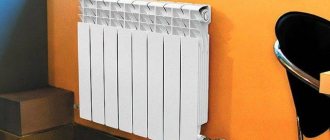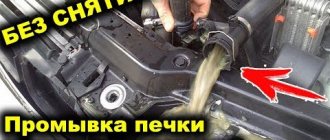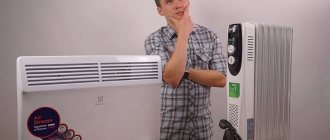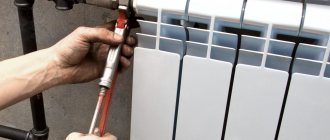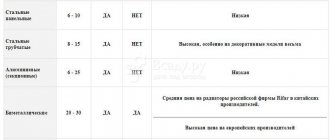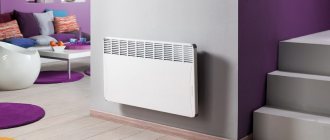The previous generation of heating devices is gradually becoming a thing of the past. They are being replaced by new heat sources with greater heat output. How to choose the right radiator, what characteristics you should pay attention to - this is what our article is about.
Read the tips before purchasing a radiator.
Since the radiator is located indoors and significantly affects its aesthetic appearance, many buyers approach the choice of a device solely from a design standpoint. This is normal if you need to heat a private cottage equipped with an autonomous heating system. If it comes to a city apartment, a number of restrictions immediately arise. First of all, the radiator must be strong enough to withstand the pressure maintained in the home's heating system.
Aluminum radiator design
The aluminum heating radiator consists of separate sections connected to each other at the top and bottom. Inside each section there is a vertical channel for the flow of water or coolant.
On the sides of each section there are “feathers” - vertical plates, with the help of which the metal gives off heat. Most aluminum radiators have cut-offs - plates located on top that remove heated air indoors (see figure).
Aluminum radiator air cut-offs.
How a steel radiator is made
Steel panel radiator is a non-separable design. Its heating element consists of two horizontal tubes, between which there are vertical ones through which water circulates.
Between the tubes there is a Z-shaped or U-shaped plate (casing) along the entire length of the radiator. It warms up from the element and gives off heat to the air. This entire structure is enclosed in a steel casing, in the upper part of which there is a grille for air circulation.
Steel radiators come in three main classes: 11, 22, 33. They differ in the number of heating circuits and casings:
- 11 – one circuit, one casing;
- 22 – two circuits, two casings;
- 33 – three circuits, three casings.
Types of steel panel radiators.
Heating radiator classes
The classification of heating radiators can be indicated by the following list:
- sectional;
- tubular;
- panel;
- lamellar.
Sectional
The design of this class of batteries is a combination of two or more hollow flow vessels (sections) in one radiator. The number of sections varies depending on the thermal design of the room. They come in both aluminum and cast iron models.
pros
The advantage of such heating devices is that you can always increase or decrease their heat output (see table) by adding or removing sections. To assemble the battery sections, you will need external thread fittings (nipples), O-rings, connecting pipes and a special wrench. Sectional heating devices can quickly be disassembled into separate sections or assembled into a reliable product.
Minuses
The structure, consisting of several elements, has many connecting points. Loose connections can result in battery leaks.
Tubular
Tubular radiators began to be installed back in the 30s of the last century. They have always been considered piecemeal devices. That is, they are supplied to the customer on an individual order. This class of batteries enjoys the greatest success among designers. Steel radiators can be either with horizontal or vertical tubes.
pros
Like all custom-made products, tubular steel appliances are in demand among owners of expensive country mansions.
The use of any bold design solutions makes it possible to install tubular radiators not only as heating devices, but also to make them one of the bright accents in the interior of any room. The thermal characteristics of steel products are high.
Minuses
The disadvantages of tubular heaters for an autonomous heating system include inaccessibility for most consumers due to the high price of the products, and “capriciousness” in relation to the quality of the coolant (coarse and fine filters must be installed).
It should also be noted that this class of batteries refers to non-separable devices, and partial replacement of individual segments is impossible.
Panel
Screen heaters are also non-separable devices. The look of solid panels, painted mainly in neutral tones, is in fairly high demand among ordinary consumers.
Rectangular steel radiators consist of 2 parallel steel planes welded to each other, inside which U-shaped tubes are located. Steel strips are placed along the perimeter of the ends of the battery. The panels can be either with a side or bottom coolant supply.
pros
Panel steel radiators have high heat transfer characteristics, they are compact and their appearance harmonizes with any interior of the room. Panel appliances are especially popular in private homes with large window openings.
Long screen heaters are placed in niches or simply under windows so that they cut off the cold influx of the external atmosphere from penetrating into the premises.
Minuses
Panels that have been subjected to water hammer or mechanical damage with rupture of the steel surface cannot be repaired. Batteries cannot be disassembled and their dimensions cannot be adjusted. The devices look quite monotonous in appearance.
Lamellar
They can, in some cases, be classified as bimetallic types of batteries and converter devices. The idea of the design is that a steel pipe with coolant is placed through a set of thin steel, aluminum or copper plates.
pros
The more petals, the larger the heat transfer area. Therefore, a small-looking device in a private house will heat a room just as effectively as its much larger panel, sectional or tubular counterparts. The trouble-free service life is 20 years or more.
Minuses
The main disadvantage of plate heaters is that the plates, with their area, increase not only the heat transfer of the device, but also attract a large amount of dust.
Accumulations of lightly suspended particles in a private home can cause allergic reactions in people present in the room. Therefore, batteries of this type need to be cleaned regularly with a vacuum cleaner.
The whole difference is in thickness
Aluminum radiators have thicker feathers and walls. Moreover, it does not particularly affect the heating efficiency, since this metal has good thermal conductivity. But due to the thickness, the strength of the heating device increases, which makes it possible to work with coolants at high temperatures and under high pressure.
Steel radiators are made of fairly thin metal. This is done in order to compensate for the low thermal conductivity of steel. The small thickness of the walls of the tubes and plates makes it possible to effectively heat the room, but has a negative impact on strength.
Most popular manufacturers
The manufacturing features of metal radiators most often force a company to focus on producing one type. For the Russian market, adapted products with appropriate internal processing (protective film, etc.) are most often supplied.
With the onset of cold weather, the sale of aluminum and bimetallic radiators from heating industry giants such as Global, Royal Thermo and others intensifies. Consider the well-known models:
1. Bimetallic devices from the Italian company Global of the Style, Plus and Extra series are designed taking into account Russian realities. They are distinguished by rounded shapes and the presence of an additional convection rib. They have increased heat transfer - up to 190 W per section, withstand pressure up to 35 atm. The simple but ergonomic design eliminates air locks.
2. Royal Thermo BiLiner bimetallic radiators have a stainless steel core that is neutral with respect to super-aggressive thermal fluids. Design taking into account aerodynamic laws, unique shapes of convection windows ensure high efficiency of the device and uniform distribution of heat throughout the room.
Aluminum devices from the same manufacturer of the Revolution, Indigo, DreamLiner series are manufactured by casting with a two-layer powder coating. A wide vertical collector provides greater heat transfer; the internal space is treated with a special anti-corrosion compound. Working pressure – up to 16 atm.
3. Bimetallic Santekhprom BM are designed taking into account Russian centralized heating, have thickened core walls, pressure - 16 atmospheres, maximum - 23. The service life of the unit is at least 25 years.
4. The Russian company Rifar produces aluminum and bimetallic radiators with a wide center distance, which gives a high degree of heat transfer combined with a maximum safety margin. The devices provide a flow of 100 to 200 W. The Basic bimetal series is designed for new buildings. Monolith with welded seams is perfectly adapted for apartment buildings with severe wear and tear on the system. Aluminum radiators Alum operate under pressure up to 20 atmospheres, have low hydraulic resistance to the movement of the coolant, and are unpretentious to the composition of the liquid.
The cost of devices is an important factor in the eyes of a potential buyer. Often, high-quality products “sit” in the same price niche due to special characteristics, increased safety margins and design. More details about the cost in Moscow and the Moscow region are presented in the table below:
| Name | A country | Products | Price per section | |
| Global | StylePlus | Italy | BM | 600 |
| Extra | BM | 650 | ||
| Royal Thermo | BiLiner | Italy | BM | 550 |
| Revolution Indigo DreamLiner | A | 500 | ||
| Santekhprom BM | Russia | BM | 540 | |
| Rifar | Basic | Russia | BM | 480 |
| Monolith | BM | 620 | ||
| Alum | A | 420 |
Who is warmer?
The efficiency of aluminum radiators is higher than that of steel, but only on average. If you compare a regular aluminum battery and a class 33 steel radiator, the latter will be able to give off more heat. But it is worth considering the type of radiator connection and the water flow rate.
Example
If you have a class 33 steel radiator installed and the water flow rate is low, it will work efficiently. That is, it will take maximum heat from the water. If a single-pipe connection is used, this is bad - cooled water will enter the next heating device and it will not heat.
If a steel radiator of class 11 or 22 is installed, then they will also heat well, but will not have time to cool the water.
It is impossible to say exactly how much more heat transfer from an aluminum radiator is greater than that of a steel radiator - a lot depends on the design and thickness of the metal. On the one hand, the thermal conductivity of steel is on average 3.5-4.5 times worse than that of aluminum. But the thickness of the steel radiator tubes is also less, which can compensate for this difference.
Features of connecting aluminum radiators
There are three ways to connect radiators:
- Lateral . The supply pipe enters from above, and the outlet pipe is connected from below on one side.
- Diagonal . The entrance and exit are located diagonally.
- Lower . The supply and outlet pipes are located below on different sides.
The most effective is a diagonal connection, in which heat losses are only 2%. With a bottom connection, the loss reaches 15%, but the pipes can be completely hidden under the floor. The connecting elements used when installing aluminum batteries must be resistant to corrosion.
When connecting, it is necessary to install special automatic valves that ensure the release of air that accidentally enters the system. Their outlet heads should point upward.
What kind of water do radiators like?
Aluminum is very sensitive to water quality. With increased acidity or alkalinity, gas is formed in it, which creates an air lock and impairs the heating efficiency. you have to periodically remove air from the battery manually or using a Mayevsky tap.
In addition, aluminum can react with chemicals contained in water or poor-quality coolant. It begins to corrode, which does not happen with steel radiators.
Steel is a chemically inert metal; it does not react with coolants and chemicals dissolved in water. The only danger is corrosion, which can form while the water is drained from the heating system. But good manufacturers cover the internal channels with an anti-corrosion coating or paint.
Supply of high-quality bimetallic radiators on favorable terms
The Ogint company carries out wholesale supplies of modern bimetallic radiators. We are a direct manufacturer. For the manufacture of radiators, only advanced technologies and materials of excellent quality are used. This allows for efficient, reliable and durable operation in heating systems of any type. We offer certified heating devices that fully meet the requirements of domestic standards and are excellent for operation in Russian conditions.
Ogint radiators are characterized by an optimal price-quality ratio. By contacting us directly, you can get the best possible price. To place a wholesale order of radiators, you can use the contact form on the website or call us by phone.
Catalog of bimetallic radiators Ogint:
Bimetallic radiators
Operation and Maintenance
Steel radiators are produced in the form of finished panels. If the heating battery power is calculated incorrectly, you will have to add a new one.
With an aluminum radiator, everything is simpler - if desired, you can add one or more sections, or remove unnecessary ones. You can do this yourself.
The service life of aluminum radiators depends significantly on the manufacturer and model range. The cheapest ones will begin to leak after 5 years, or will crack with a slight water hammer (see photo). And expensive models can last 20 years or more.
An aluminum radiator burst due to water hammer.
It's more difficult with steel radiators. By definition, they cannot be particularly durable - thick metal will worsen their thermal conductivity. Therefore, they are afraid of high pressure and quickly wear out when it changes.
But if the system has stable operating pressure and there are no water hammers or surges, then a steel panel radiator can last 15 years. In addition, in case of problems, it can be “patched up”. This is much easier to do than repairing aluminum.
As for special care, neither steel nor aluminum require it. Unless you need to wipe them from dust, which is easier to do with a steel radiator.
Cast iron heating radiators for home. Not at once!
Before conducting a comparative analysis, you will have to immediately cut off the cast iron representatives. Why? Domestic cast iron batteries have many significant disadvantages, but poor resistance to high pressure and poor-quality intersection gaskets are the main ones . Cast iron batteries require mandatory disassembly and replacement of gaskets before installation. Otherwise, a leak will certainly appear in the system, especially if there is antifreeze as the main heat conductor. Independent disassembly and replacement of gaskets is the best option, but not everyone can do this with their own hands. When turning to professionals, a cast iron battery will be more expensive than a bimetallic or aluminum one. That is why, despite reasonable prices, high corrosion resistance and long service life, these radiators are not truly economical and are installed extremely rarely. Another thing is bimetallic and aluminum radiators - it is better to install them in the house.
Where is steel better and where is aluminum?
Which heating radiators are better for a private house, and which for an apartment? The answer to this question is simple.
In a private home, you can monitor the quality of water or coolant. In an individual heating system, there are no water hammers or large pressure drops. A steel radiator in a private home will last a long time.
In apartments with a central heating system, it is impossible to check the water quality. Changes in temperature and pressure in the central heating system The contents of the hint are not uncommon. So using steel radiators is quite risky - it’s better to fork out money and install aluminum ones.
Steel radiators are, on average, cheaper than aluminum ones. Of course, among both types there are premium models from well-known manufacturers, which differ in design (see photo) and are more expensive than usual. But if we take the middle class, then steel costs less.
Custom aluminum radiator.
Non-standard steel radiator.
Features of installing steel radiators
When installing steel batteries, the same connection methods are used as when installing products made of aluminum alloys. You need to decide how the connection will be made before purchasing the products.
When installing panel batteries, it should be taken into account that the distance from them to the walls should be 20 (or more) centimeters. Otherwise, heat losses will increase significantly.
When installing the panels, it is necessary to maintain horizontality to prevent stagnation of the coolant in individual parts. It is also necessary to choose the right places and types of fastenings. All this will ensure reliable operation of the entire heating system.
Steel and aluminum radiators, comparison (table)
| Parameter | Steel | Aluminum |
| Efficiency | — | + |
| Number of species | + | — |
| Coolant requirements | + | — |
| Possibility of improvement | — | + |
| Life time | +/- | + |
| Ease of use | + | — |
| Warm-up and cool-down speed | + | + |
| Design solutions | +/- | +/- |
| Price | + | — |
As you can see, it is impossible to say for sure which batteries are better, aluminum or steel. both options have their pros and cons. So you need to choose one or another type of radiator depending on your needs.
We hope the article was useful to you. You can leave your opinions and questions in the comments. Don't forget to share the post with your friends!
Do you want to get help from a master, a specialist in this field? Go to the professional search portal. This is a completely free service where you will find a professional who will solve your problem. You do not pay for posting an ad, views, or choosing a contractor. If you are a master of your craft, then register on Pro and receive a flow of clients. Your profit is just one click away!
Best answers
Paul Ac:
Aluminum radiator:
1. Working pressure - 16 bar. 2. Pressure testing - 24 bar. 3. Safety factor - 60 bar. 4. Maximum coolant temperature - 120°C
Bimetallic radiator:
1. Maximum coolant temperature -110 C 2. Maximum operating pressure - 20 bar 3. Crimping pressure - 30 bar 4. Heat transfer of 1 section - 171 W 5. Inlet - 1″
BABY:
Heat exchange during heating.
Maria Leon:
Bi is more expensive. And everything is Chinese.
Alexey Fedorov:
Bimetal is better. Withstands heavy loads and has a longer service life.
The Scarlet Flower:
Probably only for the price, but they heat the same. I recently did heating work, the technician advised me to use aluminum ones, he said that they have better heat transfer, the heating was fine in winter, it was hot.
vonemugI:
For an apartment, bimetal is better because it is less susceptible to destruction from aggressive components in water and holds pressure more than aluminum. Aluminum will be fine for a private home, where the system is filled with a special antifreeze. In general, you know that there is nothing more reliable and better than cast iron. You can find out more here - .glavteplotorg /scat/cat36
vikont.X:
no difference at all. Let's say the boiler produces +50 degrees. , then the heat exchanger will be +50 degrees. , even if it is made of gold. the only difference is... If you turn off the gas, some will cool down faster than others. The same thing happens when they are heated, some heat up quickly, others more slowly. everything goes to zero. buy according to your pocket. advice: cast iron ones need to be checked with a dosimeter, a lot of this junk is brought to us secretly from Chernobyl.
Yuri Nevkryty:
I agree with the opinion that bimetal is definitely better, even for a private home.
Alex Mishin:
In my apartment, aluminum radiators have been serving perfectly for 12 years - domestic ARRPZ, now, alas, they are very difficult to find on sale. Imported models are worse in that they have thinner internal channels through which the coolant flows.
Bimetallic radiators come in two fundamentally different designs. In some, a steel tube from the radiator fin goes into an aluminum manifold, and a galvanic couple is obtained in contact with water. Corrosion of aluminum in this place is, of course, extremely intense. In the second case, the water flows entirely through a labyrinth of steel tubes. The tubes are covered with aluminum on the outside. In this case, it is generally not clear - what is aluminum for then? !
Why were bimetallic radiators invented in the first place? Yes, simply because it is easier for the manufacturer to take ready-made steel tubes than to form channels directly in aluminum! And the marketing of the result is intended to ensure the eloquence of advertisers...
Sergey Arefev:
The site offers all different types of radiators and more. s.a-lpha
